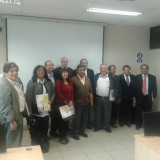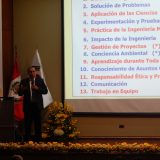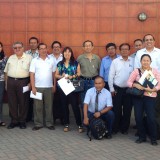1. Problem Solving
Identify, formulate and solve complex textile engineering problems properly applying the principles, methods, techniques and tools of engineering, science and mathematics.
| Capacities |
| Identify and diagnose problems and prioritize them according to their impact and relevance. |
| Propose and develop adequate and realizable solutions using appropriate norms and standards. |
| Identify and use techniques and methodologies of mathematics, science and engineering to describe, analyze, simulate and implement solutions to engineering problems. |
| Operate and use equipment, instruments and software required for textile engineering practice. |
| Takes in to account safety measures in the practice of engineering. |
2. Engineering Design
Design and integrate textile engineering systems and components that meet specified needs with consideration of public health, safety, and welfare, as well as global, cultural, social, environmental, and economic factors.
| Capacities |
| Interpret requirements and needs and translate them into the formulation of an textile engineering project. |
| Formulate and analyze the specifications of a design project considering technical variables, as well as realistic economic, social, legal and environmental restrictions. |
| Propose and evaluate solution alternatives to select the most adequate satisfying requirements and constraints. |
| Present and describe the solution through specifications, planes, engineering drawings, diagrams and virtual simulations. |
| Propose the process to implement the solution. |
3. Effective Communication
Communicate clearly and effectively in oral, written and graphical formats, interacting with different types of audiences.
| Capacities |
| Express their ideas clearly and concisely using the adequate technological support. |
| Elaborate clear and precise technical documentation using norms, symbology and terminology proper of textile engineering. |
| Adjust their speech according to the type of audience for getting a proper understanding and interpretation. |
| Read technical documentation in English. |
4.a Ethics and Responsibility
Recognize and assume ethical and professional responsibilities in engineering situations and make informed judgments.
| Capacities |
| Anticipate the implications of their decisions, as well as the results of their actions and projects. |
| Carefully analyze the antecedents of a problem for making informed and thoughtful judgments. |
| Appraise the punctual and responsible fulfilling of their personal and professional duties. |
| Takes into consideration community interests and the social benefit. |
| Knows and act according to the professional code of ethics. |
4.b Engineering Impact
Understand and consider the impact of engineering solutions on people and society in local, global, economic, environmental, and societal contexts.
| Capacities |
| Recognize the role of textile engineering on the progress of society, and the wellbeing of people. |
| Identify and appraise the economic and social benefits of engineering works. |
| Recognize the importance of engineering for the creation and innovation of products and processes. |
| Understand the role of engineering in risk prevention and disaster mitigation. |
5.a Teamworking
Appraise the importance of teamworking and participate actively and effectively in multidisciplinary teams whose members together provide leadership, creating a collaborative and inclusive environment.
| Capacities |
| Promote the creation of highly committed, friendly, collaborative and inclusive working groups. |
| Can perform as leader or active member of a working team effectively participating to achieve goals. |
| Propose and accept ideas conducting to the achievement of objectives and results. |
| Appraise the differences of opinion, is tolerant and respect agreements. |
5.b Project Management
Within the context of a team, determine the feasibility of engineering projects, establish goals, plan tasks, and formulate schedules and budgets for the attainment of objectives.
| Capacities |
| Formulate the objectives and restrictions of an engineering project and propose strategies for implementation. |
| Determine the scope of a project, its activities and priorities, and propose execution and control schedules. |
| Identify the required resources and their costs, and estimate the budget of textile engineering projects. |
| Determine the technical and economic feasibility of an engineering project, as well as its social and environmental viability. |
6. Experimentation and Testing
Develop and conduct appropriate experimentation, analyze and interpret data, and use engineering judgment to draw conclusions.
| Capacities |
| Determine objectives and restrictions of the experiment or test to be performed. |
| Determine the required equipment, tools and materials according to the experiment to be done. |
| Discriminate the relevant variables of an experiment, relating, measuring and quantifying them, and determining their tolerances. |
| Analyze and process data and results using proper concepts and criteria. |
| Use the scientific method for developing experiments, design and research projects. |
7. Autonomous Learning
Acquire and apply new knowledge for keeping themselves updated and competitive, using appropriate learning strategies.
| Capacities |
| Identify relevant areas for the development of their professional career. |
| Keep themselves up to date on new tendencies and technologies of textile engineering, as well as their diverse applications. |
| Be autonomous in their learning process, applying appropriate learning strategies. |
| Identify and apply information and communication technologies that facilitate the learning process. |
| Recognize the importance of taking part in research groups and participate in student branches of professional societies. |
| Attend and participate in events of professional and personal development. |
8. Environmental Awareness
Takes into account the importance of preserving and improving the environment in the development of their personal and professional activities.
| Capacities |
| Promote the use of materials, technologies and processes that are environmentally adequate. |
| Make a rational use of natural resources understanding their importance in the life of people and society. |
| Promote the sustainable development in their professional activities and apply norms of environmental management. |
| Participates in activities and campaigns for environment and ecosystems conservation and improvement. |

 Download
Download








